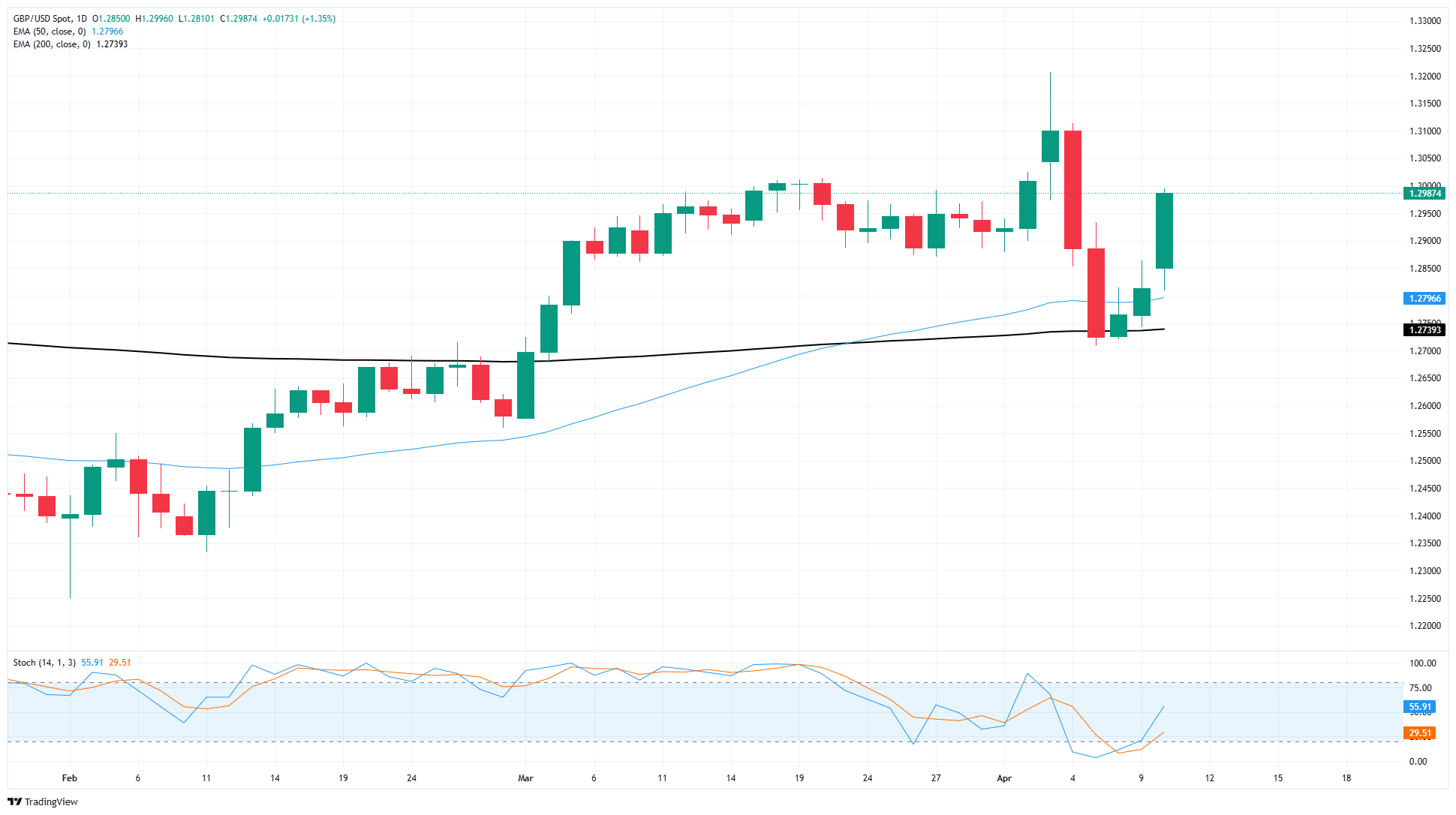GBP/USD lurches higher as risk aversion abates
- GBP/USD took a leg higher on Thursday but still remains capped below 1.3000.
- Tariff tensions have eased for the time being, but market conditions still aren’t great.
- A reversal in Greenback flows across the board has bolstered the broader market.
GBP/USD took another bullish step higher on Thursday, bolstered by a broad-base weakening in Greenback demand after US Consumer Price Index (CPI) inflation cooled even faster than expected. Coupled with a general easing in risk-off flows following the Trump administration’s constant carousel of on-again, off-again tariffs, Greenback strength across the board has been receding, giving Cable an opportunity to rebound from recent losses.
US Consumer Price Index (CPI) inflation came in well below expectations in March. Core CPI eased to 2.8% YoY, reaching a four-year low after stubbornly holding above 3.0% for nearly eight months. Headline CPI inflation also eased to 2.4% YoY, and investment markets will be devastated if tariffs undo years’ worth of work by the Federal Reserve (Fed) to bring inflation to heel.
This week will wrap up with University of Michigan (UoM) Consumer Sentiment Index survey results on Friday. The UoM Consumer Sentiment Index is expected to contract yet again in April as consumers continue to buckle under the weight of the Trump administration’s tariff and trade “strategy”, and is expected to sink to a nearly three-year low of 54.5. Consumer Inflation Expectations are also on the cards for Friday. UoM 1-year and 5-year Consumer Inflation Expectations last clocked in at 5% and 4.1%, respectively.
GBP/USD price forecast
A third straight day of gains has pushed Cable into the high side, though the pair remains trapped just below the key 1.3000 price handle. The Pound Sterling rallied 1.3% against the Greenback, and GBP/USD is up nearly 2.2% from the last swing low into the 1.2700 handle.
Price action caught a technical bounce off of the 200-day Exponential Moving Average (EMA), but the next immediate challenge for bulls will be an inflection point at the 1.3100 region.
GBP/USD daily chart

Pound Sterling FAQs
The Pound Sterling (GBP) is the oldest currency in the world (886 AD) and the official currency of the United Kingdom. It is the fourth most traded unit for foreign exchange (FX) in the world, accounting for 12% of all transactions, averaging $630 billion a day, according to 2022 data. Its key trading pairs are GBP/USD, also known as ‘Cable’, which accounts for 11% of FX, GBP/JPY, or the ‘Dragon’ as it is known by traders (3%), and EUR/GBP (2%). The Pound Sterling is issued by the Bank of England (BoE).
The single most important factor influencing the value of the Pound Sterling is monetary policy decided by the Bank of England. The BoE bases its decisions on whether it has achieved its primary goal of “price stability” – a steady inflation rate of around 2%. Its primary tool for achieving this is the adjustment of interest rates. When inflation is too high, the BoE will try to rein it in by raising interest rates, making it more expensive for people and businesses to access credit. This is generally positive for GBP, as higher interest rates make the UK a more attractive place for global investors to park their money. When inflation falls too low it is a sign economic growth is slowing. In this scenario, the BoE will consider lowering interest rates to cheapen credit so businesses will borrow more to invest in growth-generating projects.
Data releases gauge the health of the economy and can impact the value of the Pound Sterling. Indicators such as GDP, Manufacturing and Services PMIs, and employment can all influence the direction of the GBP. A strong economy is good for Sterling. Not only does it attract more foreign investment but it may encourage the BoE to put up interest rates, which will directly strengthen GBP. Otherwise, if economic data is weak, the Pound Sterling is likely to fall.
Another significant data release for the Pound Sterling is the Trade Balance. This indicator measures the difference between what a country earns from its exports and what it spends on imports over a given period. If a country produces highly sought-after exports, its currency will benefit purely from the extra demand created from foreign buyers seeking to purchase these goods. Therefore, a positive net Trade Balance strengthens a currency and vice versa for a negative balance.

